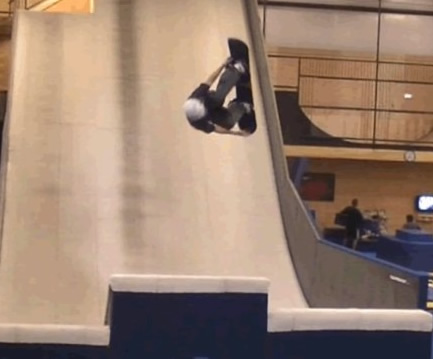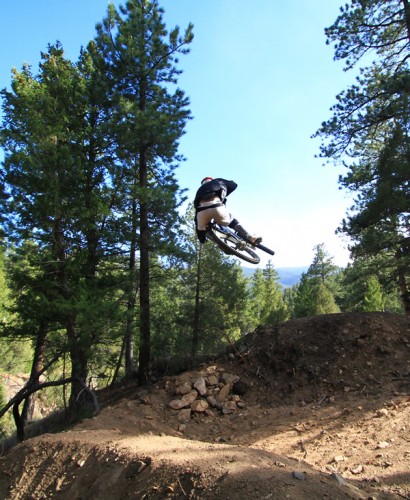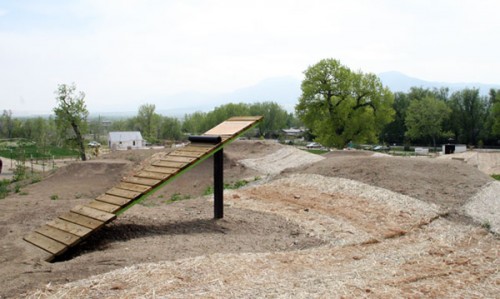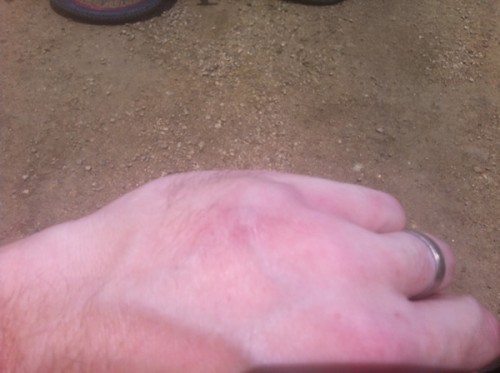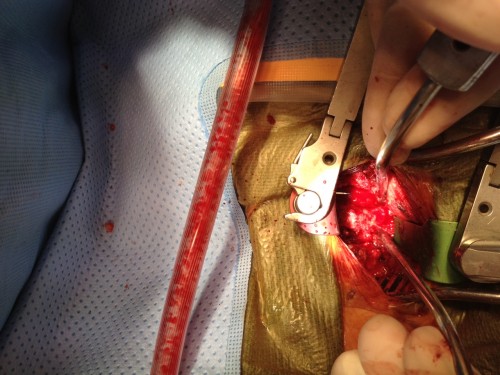START HERE: “Creating Lag in the Downswing Secret” Video
I’m Chuck Quinton, and on June 11, 2011, I almost died.
Over the course of the next few days, I almost died 3 more times.
It’s amazing how quickly life can change. One instant all is well, the next you’re laying in the ER and overhear, “Bed 19 is going to need a neuro consult. He broke C1 in three places.”
My first thought was, “Oh man, poor bastard!” Then, as I watched my wife’s face completely drain of blood and turn pale white, my next thought was, “Oh f#&k, what bed am I in again?”
Life was going very well for me on June 11, 2011. It was opening day at the Valmont Bike Park in Boulder, CO.
I had spent my last few summers in Colorado; originally as the Teaching and Playing Professional at Castle Pines Golf Club, and later as a competitive downhill mountain biker. But once I heard about Valmont, I knew I had to move there for the summer so I could practice my 360′s and backflips on my mountain bike every day.
Now, you may ask yourself, “Why the hell is a former professional golfer and well known golf instructor risking his life mountain biking?”
The simple answer is, there’s more to life than golf, and I was a professional snowboard mountaineer long before I was ever a pro golfer. I’ve always had a penchant for thrill seeking, and my love for mountain biking knew no rival.
But things change…
I had been waiting for opening day at Valmont literally for months. I couldn’t wait to launch over the huge wooden and dirt jumps.
I had stopped playing professional golf in 2009 after a busy summer teaching at Castle Pines because I simply got burnt out. Teaching and playing every day while throwing in a few tournaments here and there had taken their toll on me mentally, and I needed a change of pace.
Getting back into competitive mountain biking was the perfect escape, and I started racing downhill in 2010. My last two races of the season I placed 1st and 4th, and so when the 2011 season was ready to start, I was fired up to whoop some ass. I could hardly contain myself.
And then it happened…
Opening day at Valmont was a big affair. Hundreds of people were there, and thankfully, so were the paramedics.
Valmont is a “big boy” freeride style park with wooden and dirt jumps nearly 10 feet tall, so the chances of getting hurt are pretty high. But the chances of having fun are even higher.
I got there early that morning and was riding all the lines, which range from Small to Large, by mid-morning.
My first run on one of the XL lines was also my last.
Having hit some big jumps and feeling comfortable, I worked over to an XL line that had a good sized drop with a 10 foot gap that then ran into another jump with two gaps.
As I came off the first drop, I was cruising with some serious speed. So much so, that I felt I was going to overshoot the next gap and fly into the face of the next jump.
I started to scrub speed as I approached the gap and then as I left the lip of the jump, I “Bubba Scrubbed” the lip to avoid going too far. Unfortunately, I misjudged my speed, came up short and landed head first onto the wooden jump.
I’ve wrecked HARD literally hundreds of times on my mountain bikes over the past 20 years of riding. This one was nothing spectacular.
As I gathered myself off the ground, I did my usual “inventory check” – toes still work, legs still work, arms are good, SHIT, I broke my hand…. I could see a huge lump through the glove on my left hand and immediately knew it was broken.
This was a major bummer because I was supposed to be going to Whistler Canada in two weeks. Whistler is like mountain biking nirvana, and I was devastated knowing that I might not be able to ride.
As I stood there lamenting over my broken pinky bone, the paramedics had arrived and were trying to get me to sit down and started asking a bunch of annoying questions.
“What day is it? Do you know where you are? What’s your name?”
“I’m at Valmont, and it’s opening day, man! Look, I broke my hand and may not be able to go to Whistler now!”
For some reason, the paramedics didn’t seem to care much about my hand and kept asking me the same annoying questions over and over. After about 5 minutes of this, I started to realize that I was having a more difficult time focusing on what they were saying, and that caused me a little alarm.
I’ve been injured countless times over the years, so dealing with “mental check” questions is nothing new. But once I started “zoning out” a bit, I thought I better take some precautions.
So, I let the paramedics know I knew what they were doing but that I was having a harder time focusing on their questions and that I felt I “had rung my bell pretty good.”
My helmet was cracked, but I had broken three helmets over the past year and was little worse for the wear, so I didn’t give it much thought. I told the paramedics that I needed to go sit for a while. They wanted to get the stretcher and carry me down, but I insisted on walking.
“I’m no pussy, I can walk,” I told them.
As I walked down the side of the hill to the ambulance with a paramedic holding each of my arms, I was still really concerned about my left hand. Apart from not being able to go to Whistler in a couple weeks, I was STILL a golfer and instructor and the left hand is kind of important for controlling the club face!
So, as I sat in the ambulance waiting on my wife to bring the car around to take me to the hospital, I took a picture of my hand and posted it on Facebook to let my mountain biking buddies know what had happened.
Immediately, they started calling my wife, asking for details on the accident. She was in a panic. She’s seen me crash a LOT, but never seen me not just bounce back up and keep riding.
She tells my friends I’m sitting in the ambulance and that the paramedics are going to take me to the hospital. At this point, I’m still convinced I’m fine and my wife can take me as it’s only a few miles away, and I didn’t want her to freak out as I’ve NEVER taken an ambulance ride for anything.
But once she arrived with the car to pick me up, the paramedics had her convinced that I needed to be strapped down to a stretcher and put in a neck collar immediately and that they needed to drive me to the hospital.
“It’s no big deal, I just broke my hand and my head’s a little woozy,” I told them.
They weren’t buying it, and I could see the look on my wife’s face that I was going to lose this battle, so I let them strap me down and take me in the ambulance.
For the record, the ride in my wife’s X5 would have been much less painful. Do they not put suspension in those things?
From there, things went downhill – and not the fun kind of downhill.
Back to that poor bastard in bed 19…
I spent about 3 hours in the ER having X-Rays, CT scans, MRI’s, the works. After we overheard the ER doc say that I had broken my neck, he came into the room and told me that they needed to take me to ICU and keep me overnight.
My wife, who had just returned from puking in the bushes outside after hearing the bad news, looked terrified when he said ICU. So, I told her it’s no big deal, and I’m sure they do it for everyone just as a precaution, don’t worry about it. After all, my track record had proven that I was invincible, and I could handle just about any injury; sort of like Wolverine from X-Men.
The next morning I awoke to my “neuro consult”; some short, young looking dude in jeans and cowboy boots named Dr. Alex Mason. He told me I had broken C1 in five places, not three, and that I had two options:
- I could wear a halo for 3 months due to the nature and instability of my fracture and possibly still need surgery at the end of the three months, or
- I could do a C1-C2 fusion surgery now.
After consulting with good friend Dr. Brian McKeon, the team doctor for the Boston Celtics and member of the Rotary Swing Golf Medical Advisory Panel, we opted for surgery now.
At 6 am the next morning, I was wheeled into the OR to have 4 bolts and two titanium rods placed in my neck. I figured it would make me even more indestructible having some titanium bits, but there was one part that wasn’t completely clear to me when we were making the decision to have surgery – would I be able to play golf again?
To be honest, I was much more concerned as to when I could get back on my mountain bike as I was still burnt out on golf, but looking back a year later, this one moment was going to have a dramatic impact on the rest of my life that I didn’t realize until long after.
You see, the C1-C2 joint is where you get 50-60% of your rotation for your head, and they were about to bolt these two vertebrae together – permanently. I was clearly too high on morphine or whatever they were giving me at the time to realize that I was going to have a damn hard time hitting a golf ball if I could only turn my head half way.
How the hell would I even see the ball at the top of my swing? Spoiler alert – I wouldn’t.
Apparently, I wasn’t as invincible as I had thought because I bled out twice on the operating room table, requiring them to stop the surgery and give me more than two liters of blood to keep me alive.
Given that I could’ve died from the crash itself, as a large piece of broken vertebrae was perilously close to my spinal cord, and I stubbornly insisted on walking down the hill to the ambulance, and that I had now bled out twice from the trauma, you’d think things couldn’t get much worse.
You’d be wrong.
Once I was stabilized and the surgery completed, they told my wife that we’d be able to go home in a couple days, and all would be well.
Not only did I not go home, I spent the next 9 days in the ICU with a 102+ fever.
Pulmonologists, cardiologists, infectious disease specialists. They all had their hands at trying to figure out what was wrong with me.
After 9 days, my fever finally broke and I was transferred to a regular room on the neuro floor. One of the doctors decided that I had suffered a blood clot but passed it, but didn’t think I would survive the “next one.” He suggested that my wife call any family that may want to see me in case I didn’t make it.
Strike four.
After 3 days in the ICU, the nationwide mortality rate goes up exponentially, statistically speaking. I had just survived 9 days and four near death experiences. I was ready to get the f#*k out of this place.
But I wasn’t done with my problems yet. I couldn’t swallow.
There was so much trauma and swelling that I literally couldn’t swallow any food, so they had to feed me through something called a “PICC line.” Basically, they put a tube into a vein in my chest to get nutrients directly into my blood stream.
After not being able to eat anything for a couple days, I was getting desperate to get some semblance of food in my mouth. I started bribing the orderlies to sneak me a popsicle. I offered one guy a thousand dollars if he could get me a root beer flavored popsicle – I wasn’t kidding.
Eventually, after 12 days in the hospital, I was sent home – and that’s where this story really begins.
You see, I’ve had two more surgeries since this one, but we’ll get back to those soon enough.
Now you have a brief little history of what has provoked this re-dedication to the one sport that has always tugged at my heart strings in a little different way than anything else.
Golf is addicting. Maddening. Enlightening.
But more importantly, golf is my life.
It always has been since I first picked up a club at 14 years of age. And it took this near death x4 experience for me to realize it.
Above is a video clip of my swing before the accident while I was the Instructor at Castle Pines Golf Club.
Ever since I first picked up a golf club, I’ve literally been obsessed with the mechanics of the swing. I’ve always been that person that HAD to understand HOW something worked.
I’m one of the most skeptical people you’ll ever meet, so someone telling me to do something with my golf swing “just because that’s the way it works” is far from being a satisfactory answer for me.
This compulsion to understand the HOW and WHY of how things worked is exactly what led to the development of the Rotary Swing Tour (RST) golf swing system – a swing based 100% on science, research and fact and nothing more, nothing less.
But what does that have to do with me breaking my neck? It’s this research into the biomechanics of the swing that has actually allowed me to return to golf and even play competitively again – pain free.
RST has been my life’s work and is my gift to the golf world.
My work has lead to thousands of golfers being able to hit the ball like they never dreamed, and do so effortlessly and devoid of pain because I used the help of Ph. D. Biomechanists from the US Olympics Committee and orthopedic surgeons from around the US to help me develop my swing system.
Anything I’ve ever had a question on regarding how the swing should be taught, I would ask them and get a medical reason for why it should or shouldn’t be done this way to prevent injury or pain.
Which has led me back to my own swing. A swing that has been admired by thousands but now must evolve once again.
If I’m ever to play golf again at a high level, I MUST follow the RST program exactly as I’ve laid it out, or I simply won’t be able to play. My injuries (we’ve only scratched the surface on those) are crippling, and I’m only 36 years old.
But that’s why my story is so important, that’s why I’m sharing it with the world for the first time.
My story is YOUR story.
No, maybe you didn’t break your neck, but if you’re like most golfers, you hurt after golf. You have aches and pains that keep you from fully enjoying the game that you love, that we all love.
And the truth of the matter is that it shouldn’t hurt! Golf is not a contact sport!
I’ve helped thousands of golfers over my 17 years of teaching completely rid themselves of golf-swing-related pain by teaching them the RST swing mechanics, and now it’s my turn to benefit from my research.
“But wait!” you might be thinking. “You founded RST; you developed it; don’t you already swing RST?”
Yes and no.
You see, I had some things in my swing that I used to squeak out a little more power here and there, like excessively fast body rotation (think Tiger Woods’ fast hips), that are simply not an option for me anymore.
My neck structure is permanently damaged, already arthritic, and the biomechanics of my spine are permanently changed. To make matters worse, I suffered nerve damage in the accident and lost 90% of the muscle mass of my infraspinatus, supraspinatus and teres minor on the left side.
To make a long story short, I have very limited use of my left arm in the way that it is commonly taught to use it in the golf swing. Bonus – using RST, I don’t need it!
If you’ll also remember, I severely broke the 5th metacarpal in my left hand, making it nearly impossible for me to control the club face with my left hand, as it has the strength of a two year old child.
A lot of people would pack it in, call it a day, say they’ve had a good run and pick up fishing. God knows that’s the direction my wife is pushing me in. But I hate fishing.
I NEED the challenge and competition that sports bring, and since it’s unsafe for me to mountain bike, snowboard, or do anything else I loved to do, I’m rededicating my life to playing golf at a high level.

Extra hardware in my neck. If I can play with this stuff in my neck, I can help you play with your injury!
Since my accident, I’ve played 7 rounds of golf.
My first round back was 8 months after my accident, in February 2012. I shot 81.
My longest drive was 240 yards, and I averaged about 230 off the tee. I used to hit it 340 yards off the tee with a drive of 408 yards as my longest ever!
Hitting it like this was a shocker, but I realized instantly that I missed this stupid f*%king game.
My next three rounds each got better. My fifth round of golf was the Colorado State Open Qualifier – LOL.
Yep, my fifth round of golf I decided to try and qualify for a professional golf tournament. Hey, if it’s not clear that my decision making process skills may be somewhat lacking at times, then you should re-read this article from the beginning.
Setting myself up for failure, I shot 75 with an eagle on a par 5 on the second hole in July of 2012 in the qualifier. I finished 28th out of 85 and missed qualifying by three strokes.
Normally, I’d have been pissed, but instead, I had a sense of peace about this round. The qualifier was just over a year since my accident, and I had only played 4 rounds of golf over the past 13 months.
I had survived a terrible accident, hadn’t practiced hardly at all and was back playing golf at a professional level PAIN FREE.
Now, I’m not proud of a 75, but given the circumstances, it could’ve been a lot worse.
I couldn’t see the ball at the top of my swing, and I had lost 25 pounds of muscle since my accident. But after all this I was relatively competitive, and my neck didn’t bother me one bit.
Now, it’s hard for me to explain to you what it’s like to play golf after breaking your neck and not seeing the ball at the top of your backswing, but let me assure that it adds significant challenge to an already difficult game.
But I had overcome it, and if I could, so could anyone else. My RST swing mechanics allowed me to return to golf and play at a reasonable level, and they can do the same for you NO MATTER your injury or ailment.
There is NO WAY I would’ve been able to play golf with the way most golf instructors teach the swing today. The amount of aggressive body rotation puts a tremendous amount of shear force on the spine, and as you can imagine, that’s simply not an option for someone with a severe spine injury.
But maybe you don’t have an injury, just a sore back, or sore neck after a round of golf. I have neither.
In fact, I have no soreness whatsoever, and trust me, my body’s wrecked.
In fact, I’m going in for my FOURTH spine surgery in a year on Wednesday, September 5th, 2012. Apart from the problems with my neck, I was told at 31 years old that I needed to have my left hip replaced by an orthopedic surgeon.
Golf KILLED my hip to the point that I thought about quitting. Instead, I started delving into the biomechanics of the golf swing, and RST was born.
Today, I have no hip pain after golf and that doctor can shove it. My left hip feels just fine.
RST swing mechanics have saved my game and my body, and they can save yours. They’ve saved thousands of golfers’ bodies already.
My golf instruction website, http://www.RotarySwing.com, has about 40,000 members, golfers like you and me, who don’t want to be sore after a round of golf anymore. Golfers who believe the golf swing should be effortless and enjoyable and should NEVER cause you any pain or soreness.
Well, I’m living proof that the RST golf swing is a completely safe and pain free, powerful way to swing the golf club, and I’m going to continue to prove it so that my story can help save the bodies of thousands more.
Over the coming months, I’m going to continue to blog about my return to golf.
I’ll talk in more detail about my injuries and how RST has allowed me to overcome every single one (did I mention my left shoulder has been dislocated more than 30 times?) and play completely pain free golf and still hit the ball 300 yards off the tee as I’ve been doing right up until this last surgery two weeks ago.
I’d still be playing right now if I didn’t have 13 staples in my neck.
I’m going to show you my swing as it looks today, and I’ll talk about the changes I’ve had to make because of my injuries so that they may help you with your swing and any injuries you may have suffered.
Join me in this journey. I don’t know where it will end.
Perhaps I’ll go back to playing some professional tournaments with a little encouragement from you guys.
Perhaps I’ll just enjoy the game and win my club championship again.
RST has given my body and mind a new lease on life, so I can enjoy the game we all love once again.
But more importantly, what will RST do for YOU and your body? What’s your story going to be?
I have literally thousands of testimonials on the website from golfers whose games have been transformed by RST.
Will you be next? There’s only one way to find out…
If you’ve got golf-swing-related pain, want to prevent golf-swing-related injuries in the future or just want to learn more about RST, visit my site at http://www.RotarySwing.com and get a FREE video membership to learn the basics of RST online and see what a biomechanically ideal swing can feel like.
Please note, if you’d like to discuss this blog, DON’T ask Christina questions over the phone. That is my wife, and she’s had to deal with this enough. You can discuss this post on our Facebook page here: http://www.facebook.com/pages/RotarySwingcom/208473937768.












